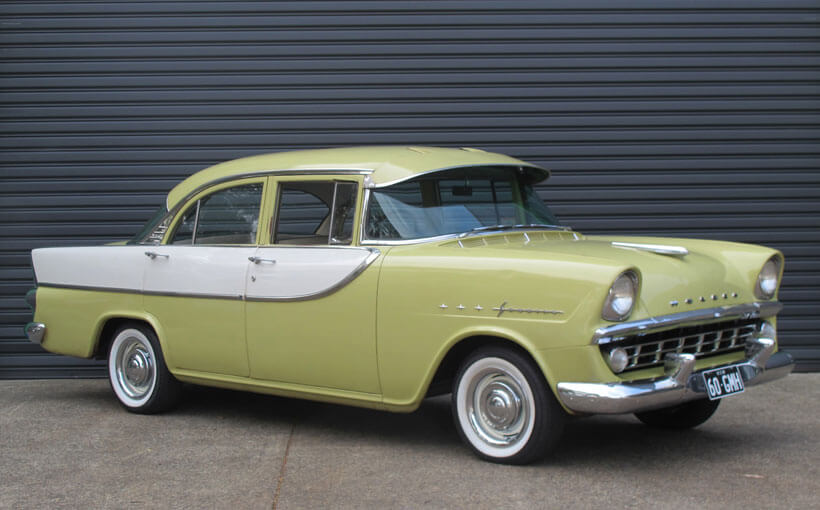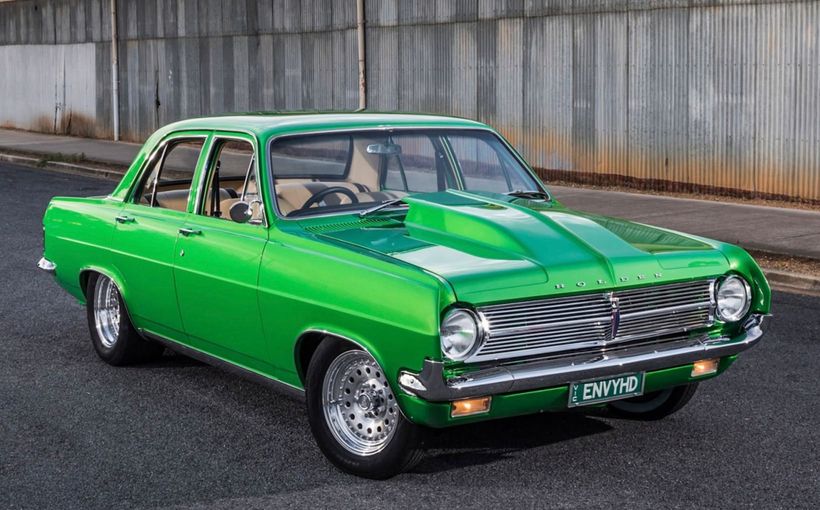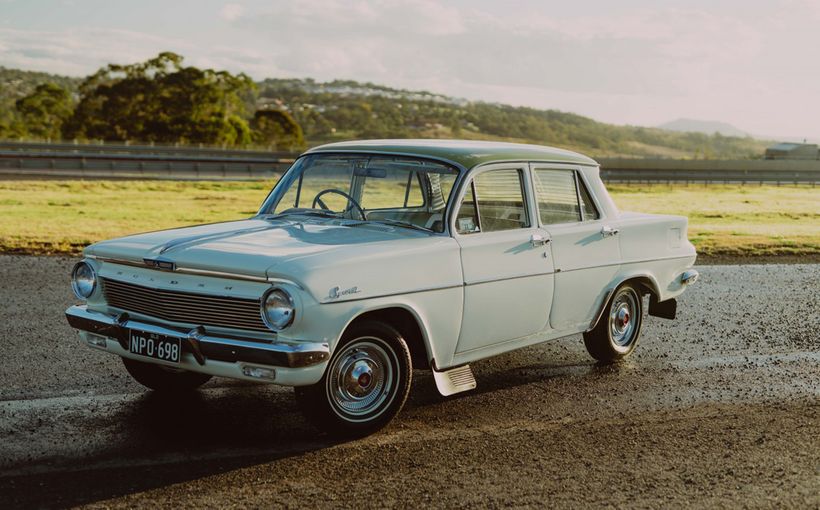FB and EK Holden: Last gasp of the 1950s

Seven weeks short of my tenth birthday, I failed to notice that the ‘all-new’ FB Holden did not live up to that promise but was, rather, a cleverly updated version of the FE/FC. Paradoxically, the flashy FB with its greatly increased glasshouse, wraparound windscreen, dog-leg A-pillar, fashionably dished steering wheel and extroverted two-tone paint combinations actually owed much of its inspiration to the 1955 Chevrolet, while its FE predecessor (and the facelifted FC) were much closer to clean-sheet designs by Holden’s in-house stylist, Alf Payze.

So, rather than being what it purported to be, namely GM-H’s third major new model (48-215, FE, FB), it was really a third go at the FE theme. This is more obvious when you look at the coupe utility and van versions.
As Joe Kenwright wrote in his excellent story on the FE, this car was almost certainly the purest and most modern design anywhere in the General Motors world of 1956 – more modern than the 1955 Chevy, much more so than the Opel Kapitän. By contrast, the themes pursued in the FB seemed to represent an attempt to import more American flamboyance for the local car: after all, the Ford Customline had become highly fashionable with the 1958 Star Model exemplifying the late 1950s obsession with chrome. The FB was longer, but this increased size conferred little functional benefit beyond a bigger boot.

The FB Station Sedan used the sedan’s roofline right back to the C-pillar which gave it a less van-like appearance, although opinions on this varied. The outspoken Bryan Hanrahan – and we’ll hear more from him shortly – was no fan!
The FB was also heavier, so that those two-point-five extra brake horsepower – up from 72.5 to 75 – were needed just to keep the performance at about the same level as the 1948 48-215 ‘FX’. Fuel consumption was up by roughly 20 per cent. Scant progress for the passing of more than eleven years since that car’s gala launch.
Think of it like this. One of the Holden’s main rivals heading into the 1950s was the Morris Oxford. But you can hardly compare the performance of the 1959 ‘Farina’ Oxford with the struggling side-valve model of bulbous shape that sold well in an Australia starved of new cars; many people settled for Morris Oxfords and even Austin A40s because the waiting list for a Holden in 1950 was at least two years.
Throughout the 1950s, most of the Holden’s rivals that had been so outclassed in 1950 or even 1953 played catch-up. The most obvious examples are the Ford Zephyr, GM’s own Vauxhall Velox/Cresta and the Peugeot (the 203 was great but fell well short of the Holden’s performance; the 403 was even greater and did not).
Nineteen-sixty was the first year that the Holden faced direct competition from six-cylinder rivals. The Zephyr had always been appreciably dearer, but the Falcon cost only a little more than an FB. Also, Australian Motor Industries released its first six-cylinder Vanguard.

There’s another clue to the design of the FB in its model code, which simply stood for 1959. The car missed its date with the 1950s by 14 days, launched on 14 January of the new decade; it was so obviously a car designed for the late 1950s (never forgetting the almost unbelievable 1959 Cadillac Eldorado Biarritz, the height of whose tailfins represented the last halcyon days of Harley Earl’s reign as General Motors’ – and, indeed, Detroit’s – design supremo).
Australian journalists never showed the reticence of their British counterparts in expressing criticism of new cars, but there was a feeling that the FB was being damned with faint praise. Consider what Bryan Hanrahan wrote in his road test of the new Holden for the February 1960 edition of Modern MOTOR:
Appearance is a personal affair, and it’s no part of my job to try to influence anyone.
Personally – and only personally – I like the look of the FC much better, especially in the station wagon version. But I’m prepared to bet that 50 per cent of Mr Average Motorists won’t agree with me.
I’ve often wondered why the keep-up-with-the-Joneses types haven’t got fed up with living in a street with 20 houses and waking up in the morning to see 20 Holdens parked…
But let’s get down to the facts about the ‘new look.’ Forget the saucer taillights and happily restrained tailfins.
The turret-top of the car is much deeper and more rigid: it doesn’t look as if it will bend in the middle. Therefore it’s a good thing.
But the seat is too high for the door shape – as you get in and out, your head fouls the top of the door opening.
Reason for the high raked seat and vertical squab is to ensure that the driver’s legs are bent and he doesn’t need an aftwards seat adjustment that would reduce leg-room in the rear compartment. But this has been rather overdone this time.
Bryan Hanrahan’s conclusion follows on from his comments on the keeping up with the Joneses factor and the need for frequent facelifts to retain buyer interest:
So, apart from looks, Mr Familyman and Mr Average Motorist, your Holden is little changed. I can see no reason why GM-H should change it drastically – unless someone else produces something that can do the same honest, reliable function on the same modest budget.
That ‘someone’ was destined to be Ford Australia with the Falcon. But probably fortunately for GM-H, the first XKs quickly acquired a (not altogether justified) reputation for frailty. Even so, the FB was not able to retain Holden’s 50 per cent share of the passenger car market achieved by the FC and the marque never again experienced such dominance.

Arguably, GM-H should have spent more money on the mechanicals than it did. At launch the FB still used vacuum-operated windscreen wipers: the more throttle you used (as in overtaking a truck), the slower the wipers went. During the life of the model the upgrade to electric wipers occurred, but why not on the debut of this ‘all-new Holden’?
Early-build FBs were the last Holdens to use duco paintwork. In May 1960 GM-H switched to ‘Magic Mirror’ acrylic, a far superior finish. But the switch has resulted in a rise in demand for the now rare early examples.
Not only did the painting process change, so did many of the colours. Among those that disappeared were Alpine Blue, Arctic Beige, Belmont Green, Corana Grey, Desert Glow and Fernando Yellow. Some were replaced: for example, Satellite Yellow superseded Fernando Yellow. And the theme of contrasting a pastel with a white flash continued. A red flash against white was popular.
It is true that in January 1960 few family sedans had disc brakes even on the front wheels. Many still used three-speed manual gearboxes and quite a few lacked synchromesh on first. But vacuum wipers were a thing of the past and most cars had a more effective handbrake than the twist and tug affair supplied on the FB (just like every ineffectual Holden handbrake before it!).
To handle the extra weight, the FB got heavier duty front dampers, wider rear leaf springs and slightly upgraded brakes. The clutch was beefier and the air-cleaner was finally the paper element type, so much better suited to the bush.
It was the first Holden with plenum fresh air ventilation.
The quaintly named Business Sedan expired with the FC range.
By the time The FB went on sale Chrysler had already introduced its Valiant to the US market with optional – it would be standard equipment on Australian Valiants from launch in January 1962 – 145 brake horsepower ‘Slant Six’ and Peugeot had introduced its stunningly effective and likeable 404 with typical Peugeot features such as camping body and all-synchromesh four-speed gearbox with an overdriven top gear. (Interestingly, one outmoded feature the Valiant shared with the FB was an external bonnet release; at least Nasco offered an internal release as an accessory for the Holden.)

The EK facelift was introduced in May 1961 in much the way the FC had been three years earlier. Instead of being described as a ‘new model’, Holden called it ‘improved’. Which it certainly was.
Far and away the most important news was that for the first time buyers could specify an automatic transmission in their Holden. This was the jerky three-speed Hydra-Matic unit. It’s fair to say that the introduction of an optional self-shifting gearbox was essential, given the Falcon’s Ford-O-Matic and the excellent Torqueflite unit that would be so popular in the forthcoming Valiant.
The EK’s 75 horsepower engine worked even harder with the slushbox, but there was some feeling at the time that the car’s appeal had been broadened. I remember my late Uncle Roy, who had Holdens for years, was keen to buy an automatic version. Like most buyers, he was not concerned with the standing quarter-mile time. It was thought that the Holden’s appeal to women was broadened by the disappearance of the clutch pedal.

Naturally, the automatic transmission sapped much needed power and the true top speed of an EK Hydra-Matic was just 75 miles per hour, compared with about 82 for a manual.
No question, the EK looked neater with its simple horizontal side chrome strip and less fussy grille. Detailing was crisper outside and in. A richer style of vinyl trim was used – Uncle Roy’s car had red seats like the one tested by Wheels editor Ian Fraser at the Lang Lang Proving Ground months before the launch. And I was smitten by the Southern Cross incorporated on the steering wheel boss (which had been introduced with FB). There was a more upmarket ambience:
Trim is improved. A new silver-thread material was a strong contrast to the red vinyl which was the basis of the upholstery on our test car. Pleasant to sit on, it was soft to the touch and probably very durable.

Notable upgrades included an interior bonnet release and additional under-bonnet soundproofing. By May 1961 the new Ford Falcon had been available for nine months and the Holden looked dreadfully old-fashioned by comparison. But at least the availability of automatic transmission, improved refinement and crisper styling kept Holden loyalists happy, while many customers buying their first car doubtless reckoned it would be a safer bet to choose a Holden.

In summary, GM-H took one step forwards and one and a half back with the FB as first presented. There was probably little to choose in terms of the overall ownership experience between an EK Special and the very popular FC (unless one needed an automatic gearbox), but in the three years that had elapsed, the automotive world had driven on.












